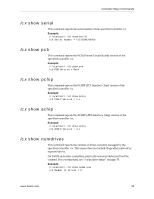3Ware 9650SE-2LPB-10 CLI Guide - Page 43
/cx show autorebuild, /cx show unitstatus, Possible statuses include: OK, VERIFYING, VERIFY-PAUSED
 |
UPC - 693494601022
View all 3Ware 9650SE-2LPB-10 manuals
Add to My Manuals
Save this manual to your list of manuals |
Page 43 highlights
Controller Object Commands /cx show autorebuild This feature only applies to 9550SX, 9590SE, and 9650SE model controllers. This command shows the Auto-Rebuild policy. If the policy is enabled, the firmware will select drives to use for rebuilding a degraded unit using the following priority order. For more information, see "/cx set autorebuild=on|off" on page 57. 1. Smallest usable spare. 2. Smallest usable unconfigured (available) drive. 3. Smallest usable failed drive. If the policy is disabled, only spare drives will be used for an automatic rebuild operation. Example: //localhost> /c0 show autorebuild /c0 Auto-Rebuild Policy = on /cx show unitstatus This command presents a list of units currently managed by the specified controller /cx, and shows their types, capacity, status, and unit policies. Possible statuses include: OK, VERIFYING, VERIFY-PAUSED, INITIALIZING, INIT-PAUSED, REBUILDING, REBUILD-PAUSED, DEGRADED, MIGRATING, MIGRATE-PAUSED, RECOVERY, INOPERABLE, and UNKNOWN. (Definitions of the unit statuses are available in the 3ware Serial ATA RAID Controller User Guide.) Note: If an asterisk (*) appears next to the status of a unit, there is an error on one of the drives in the unit. This feature provides a diagnostic capability for potential problem drives. The error may not be a repeated error, and may be caused by an ECC error, SMART failure, or a device error. Rescanning the controller will clear the drive error status if the condition no longer exists. Example: //localhost> /c2 show unitstatus Unit UnitType Status %RCmpl %V/I/M Stripe Size(GB) Cache AVrfy u0 RAID-5 OK - - 64K 596.004 ON OFF u1 RAID-0 OK - - 64K 298.002 ON OFF u2 SPARE OK - - - 149.042 - OFF u3 RAID-1 OK - - - 149.001 ON OFF www.3ware.com 37















